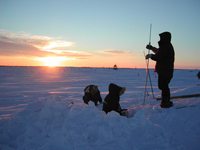Nov 23 2008
Life’s been fine for Tiffany Ellis since she graduated with a biology degree from MIT two years ago, but something’s been missing: a sense of mission and a place to make a difference, she said.
That is, until the 28-year-old Groton, MA native heard from a teacher colleague about the Earthwatch Institute, a global environmental nonprofit that has been headquartered in Metro Boston since 1971.
 Climate Change at the Arctic's Edge, Earthwatch project
Climate Change at the Arctic's Edge, Earthwatch project
“I was looking for a volunteer organization that places a premium on time spent doing real work,” said Ellis. “I wanted to get my hands dirty, all day long, and really feel I was contributing to the stewardship of our environment.”
Once she learned about the Beat the Heat Climate Change Campaign on the Earthwatch website, it all clicked, she said. “The more I explored, the more I was convinced that Earthwatch was the organization I was looking for.”
While Ellis missed Earthwatch’s 2nd annual—and carbon-neutral—fundraiser on August 14th at the Museum of Science in Boston that kicked off the two-month Campaign, she was just in time to participate in one of the three volunteering projects Earthwatch mobilized with local nonprofits for the first time in its history. And she didn’t have to contribute a dime to do it—just hands that were likely to get dirty.
Fighting Climate Change in Backyards
Ellis was one of a few dozen Beat the Heat Earthwatch volunteers who worked with the Urban Ecology Institute and the “Grow Boston Greener” project in October to plant 40 trees that will help mitigate the urban “heat island” effect, capture carbon, and get Boston closer to its goal of planting 20,000 new trees by 2020.
Inspired by Beat the Heat, Ellis decided to get her hands even dirtier: She is currently in Thailand on her first Earthwatch expedition, assisting researchers on the “Origins of Angkor” archaeology project—and plans to apply for an Earthwatch internship upon her return.
“Tiffany’s story exemplifies the power of the Earthwatch experience and underscores our commitment to our mission,” said John Jorgenson, Director of Marketing and Communications. “Climate change is happening everywhere, and before it’s too late we need to provide more opportunities for people to get involved—especially under the current economic climate.”
As part of the Campaign—which attracted more than 500 new members—Earthwatch also worked with the Ocean Conservancy’s International Coastal Cleanup on three sites in New England and the Charles River Conservancy to remove invasive species along the Charles River in Boston.
• http://www.earthwatch.org/beattheheat
Fighting Climate Change in Schools via “Live from the Field”
Earthwatch also kicked off a $1.1 million, three-year grant from HSBC in the Community, Inc., which enabled 20 teachers from around the country to participate in “Live from the Field” expeditions in recent months. They shared their experiences with their students back home via satellite phones, internet blogs and live feeds from the site of the research project—spreading the science of climate change to thousands of students.
One hundred more teachers will get this opportunity over the next two years.
Each teacher has also been awarded $250 to spearhead a local climate change project in their communities back home as part of this program. One was Adam Hovey from South Park High School in Buffalo, New York, who ventured to the Arctic to study climate change earlier this month.
“It was great to see ten dedicated teachers [literally] on their bellies and excited about permafrost. The two weeks in Churchill [Manitoba] were two of the best weeks of my life. My students benefited tremendously,” he said.
Hovey is using his funds to purchase tree-measuring equipment similar to what he used in the Arctic so that he can extend the Earthwatch experience to his urban community.
• http://www.earthwatch2.org/LFF/hovey/
• http://orangethumb.fiskars.com/the_bailey_penninsula/
• www.earthwatch.org/expeditions/kershaw.html
Fighting Climate Change in Businesses: HSBC Climate Partnership
Earlier this month, Earthwatch launched a flagship “stakeholder” climate change program at its North America Regional Climate Center in Maryland. The program is an offshoot of the HSBC Climate Partnership—designed to inspire employees to embed sustainable practices into the heart of the way they do business. HSBC is one of the world’s largest financial services organizations.
The center in Maryland, located at the Smithsonian Environmental Research Center, is one of five worldwide.
Two teams of 10-11 participants each from the regional community were accepted to participate in a five-day, fully funded program to perform real forest research alongside Smithsonian scientists by day, and learn about climate change in guided sessions at night. Their end goal: to develop action plans to implement healthy environmental change at home, at work and in their communities—such as assessing the carbon footprint of their places of work and implementing practices to reduce it.
“These local citizens—from all walks of life—devoted their own time to work with Earthwatch to become model champions for environmental change in their communities,” said Earthwatch Field Director Dan Stover. “We’ve had great success working with the HSBC employees, and it’s so rewarding to see what the citizen participants are doing in their own communities, too.”
The HSBC Climate Partnership is a $100 million, five-year program that brings together HSBC, The Climate Group, Earthwatch Institute, Smithsonian Tropical Research Institute and WWF to tackle the urgent threat of climate change on people, water, forests and cities.
• www.earthwatch.org/hsbc
• http://www.earthwatch2.org/hsbc/team2/2008/11/selection-of-community-action-plans.html
The mission of Earthwatch is to engage people worldwide in scientific field research and education to promote the understanding and action necessary for a sustainable environment. In 2008, Earthwatch sponsored 130 research projects in more than 40 countries and 20 US states, making estimated volunteer field grants of $5 million. Since its founding, the organization has supported nearly 1,350 projects in 120 countries and 35 states. More than 90,000 volunteers have contributed $67 million and 11 million hours to scientific fieldwork.